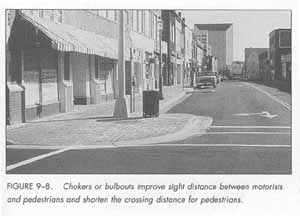Other Measures
56. Remove/Restrict Parking
On street parking has an important relationship to pedestrian and motorist safety, the capacity and level of congestion on a street, and the economic well-being of adjacent businesses. It can create a buffer, separating pedestrians on the on the sidewalk from motor vehicle traffic on the adjacent roadway. The presence of on-street parking may also reduce motorists' speed, further enhancing pedestrian safety and comfort.
On the other hand, on-street parking typically results in less visibility between motorist and pedestrians, especially for children (figure 9-1). The pedestrian dart-out, often involving children, is one of the most common types of midblock pedestrian collisions in residential areas. Therefore, the restriction of on-street parking in areas with pedestrian activity may improve pedestrian activity may improve pedestrian safety.

The issue of curb parking restrictions concerning pedestrian safety is related to the level of congestion within an urban area, the type of roadway, and the land use (figure9-2). Rural areas are not considered in this chapter due to the low number of parked cars and the low number of pedestrians present in such areas.

The primary documents for determining curb parking restrictions are the Uniform Vehicle Code (UVC) and Model Traffic Ordinance. The standard for most local jurisdictions state the "No person shall:
- Stop, stand or park a vehicle:
on a sidewalk;
within an intersection:
on a crosswalk
-
Stand or park a vehicle, weather occupied or not, except momentarily to pick up or discharge a passenger or passenger:
within 20 feet of a crosswalk at an intersection;
within 30 feet upon the approach to any flashing signal, Stop sign, Yield sign or traffic-control signal located at the side of a roadway."
Urban Area Characteristics
The urban areas where curb parking is typically present include the central business district (CBD), the central city and the suburbs. Each has unique requirements for parking related to the type of street and the traffic control devices.
Central Business District
From the pedestrian perspective, the CBD normally has slower moving vehicles, typically 25-30 mph, marked crosswalks at most intersections and restrictions on parking. Even where parking is permitted near the intersection, most intersections are controlled by some sort of traffic control device. Parking spaces are often governed by meters and, on occasion, may be marked on the pavement to avoid encroaching intersections and marked crosswalks. As long as the requirements of the UVC are met and enforced, no additional parking restrictions are generally needed.
Central City
The highest density of housing and thus on-street parking occurs in the central city. People some home from work to find parking at a premium, which forces them to park a significant distance from their homes. During the winter, this period may be during darkness with reduced pedestrian visibility. Corner parking restrictions have to be signed and enforced according to the UVC. Thus, the keys are to have an effective enforcement program and well established and maintained signs. One of the two types of signs that do not have to be reflectorized, according to the MUTCD, are parking signs. This may adversely impact upon their effectiveness.
Suburbs
Two distinct roadway types are present in the suburbs: the higher speed major routes and the lower speed collector and local streets. Because off-street parking is available on local streets in the suburbs, curb parking restrictions are normally not applicable. Housing is typically less dense. so pedestrian volumes are normally lower than in the CBD or central city.
Roadway Type
Not only is the location within the urban area a determining factor in the type of on-street parking restrictions, but the type of roadway (major arterial streets vs. collector streets) must also be considered.
Major Arterial Streets
These streets are wider, have higher speeds and usually have parking restrictions. Pedestrians are normally accommodated at marked crossings controlled by traffic control devices or at unmarked crosswalks. The curb parking restrictions listed previously are applicable to the arterial streets.
Collector Streets
Generally the width and speed of the collector streets are lower than those of arterial streets. Collector streets tend to have more on-street parking and small neighborhood shopping centers. The neighborhood stores located along the block faces of collector streets pose a particular problem due to the high volume of pedestrian traffic and the desire ;of merchants to provide as much on-street parking as possible, More signing is often necessary near these small centers with particular attention given to sight distances for pedestrian crossings.
Special Land Uses
Special areas of land use also need to be addressed. The areas discussed below are not meant to be an all inclusive list of potential cub parking problem areas but are meant to alert the traffic engineer to these and others similar areas.
Loading Zones
The primary vehicle using a loading zone is a truck. Not only are trucks wider than automobiles, but tuck are also taller. Whereas pedestrians can often see over or through an automobile, they cannot observe approaching traffic past trucks and vans. Loading zones should not be located so that such vehicles stand closer than 30 feet from the crosswalk area.
Parks
Although located along or collector roadways, community or regional size parks attract large numbers of parked vehicles during events. Due to the overflow of parked cars onto public streets, parking restrictions on the park curb faces should be considered.. Not only do children run into the road during events but every space between parked cars also constitutes a potential crosswalk. Because parks attract pedestrian trips, particularly for children, the surrounding land use must also be examined. A local park in a single family neighborhood may have ;little if any added on-street parking. However, on-street parking maybe a problem for a local park located within a high density housing area. Parking restrictions can be imposed to limit the continuous parking in front of building entrances. Fencing can be considered to channelize pedestrian flow to crosswalks at specific park entrances.
Schools
School zones represent an area of movement of small children and considerable pick-up and drop-off traffic. Some school block faces may be restricted to use by school buses only. Parking of private cars along school blocks should generally bee avoided. This, however, should be coordinated with the proper school authorities.
Business
Parking has to be viewed in terms of pedestrian paths to and from businesses. Looking at the location of attractors and generators of pedestrian traffic is important. Paths, particularly informal paths that cross streets at midblock locations, need to be examined for parking restrictions needs. Certain specialty stores, such as ice cream facilities, tend to attract children, ad may require increased parking restrictions or special monitoring. Parking restrictions should be imposed where building entrances access directly to high speed or high density roadways (although some jaywalking is inevitable), or pedestrian barricades should be considered. Curb parking should be reduced in front of other facilities with high pedestrian traffic and direct access o the street system, such as a small shopping center pedestrian entrance or movie theater side door.
Sight Distance and Parking Restrictions
The primary purpose of restriction parking at intersections is to improve sight distance. In the past, this has been done mainly for the motorist and only resulted as a side benefit for the pedestrian. The basic requirement for sight distance applies to the crosswalk area and is the stopping sight distance from the AASHTO manual (figure 9-3). Assuming an adult standing on the curb with the basic parking set back of 20 feet, the adult can see 60 feet without looking over or through the vehicle (figure 9-4). This is not adequate. If the adult pedestrian step as halfway though the parking lane, 3 feet into the street the visibility increases to 120 feet (figure 9-5). If the pedestrian, either adult or youth, stands at the edge of the parking lane, the sight distance is limited only by the individual's visual capability.
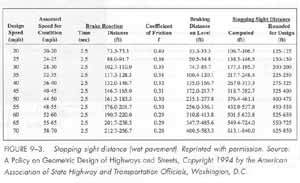
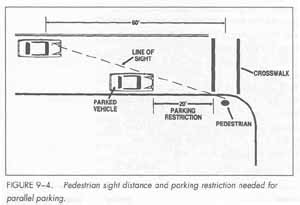
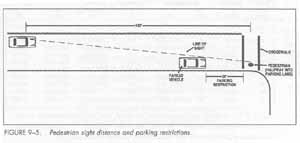
Angle parking at 90 degrees means the adult has to be 13 to 16 feet into the road before adequate sight distance is available. With the same 20 foot distance restriction from the crosswalk, the sight distance reduces to 40 feet (figure 9-6). To have the same sight distance with 90 degrees parking as with parallel parking angle parking at 90 degrees should be restricted within 30 feet of the intersection. Angle parking art less than 90 degrees, for example 60 degrees, increases available sight distance for the pedestrian looking to the left but refuses it for the pedestrian looking to the right (figure 9-7). Angle parking at 60 degrees also does not quite match the sight distance as with parallel parking (55 feet for angle, and 60 feet with parallel).
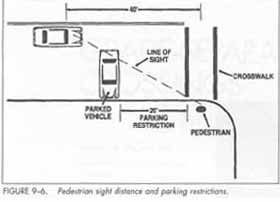
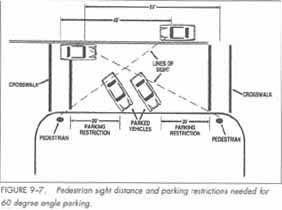
As the speed of travel on the thru street increases, the drivers' stopping sight distance increases. Therefore, the parking restriction area near the intersection has to be increased. For 35 to 45 mph, it is recommended that parking be restricted to 50 feet from the crosswalk. Above 45 mph, parking should be restricted to 100 feet from the crosswalk.
As housing density increases, the demand for parking increases. This often leads to parking on sidewalks, and in turn, the pedestrian is forced onto the street. Parking restrictions must be enforced on sidewalks and on the area between sidewalks and curbs. Midblock pedestrian crossings are usually marked with crosswalks. These crossings require greater advance parking restrictions than crosswalks at intersections, typically 100 feet minimum.
Conditions in which curb parking restrictions are most beneficial are:
-
where pedestrian dart-out accidents are common,
-
where no sidewalk exists or sight distance at the intersection is poor
-
where vehicles park too close to the crosswalk and inhibit the pedestrians sight distances.
Disadvantages to restricting curb parking are that it: eliminates parking space for motorist, is usually opposed by nearby business owners, and could lead to increases in vehicle speeds after on-street parking is removed (which is undesirable for pedestrians).
Chokers or "bulb outs" (or curb bulbs) are extensions to the curb line that extend to the edge of the parking lane and eliminate one or more parking spaces on the corner near intersections ( or at midblock in some situations). Chokers improve the sight distance between pedestrians and oncoming motorists and shorten the crossing distance for pedestrians (figure 9-8). More discussions of chokers is given in Chapter 12.
